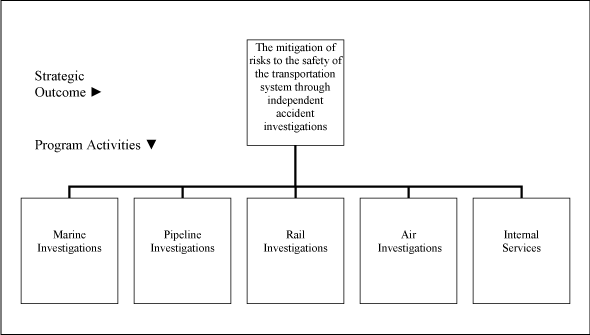Common menu bar links
Breadcrumb Trail
ARCHIVED - Transportation Safety Board of Canada
 This page has been archived.
This page has been archived.
Archived Content
Information identified as archived on the Web is for reference, research or recordkeeping purposes. It has not been altered or updated after the date of archiving. Web pages that are archived on the Web are not subject to the Government of Canada Web Standards. As per the Communications Policy of the Government of Canada, you can request alternate formats on the "Contact Us" page.
Chair's Message
The highly skilled and dedicated investigators of the Transportation Safety Board of Canada (TSB) are continuously called upon to conduct full and independent investigations into aviation, marine, railway and pipeline accidents. They painstakingly comb through wreckage, interview survivors, gather detailed, technical information from companies and manufacturers, and analyze the data to determine what happened, why it happened and what needs to be done to reduce risks.
Once again this year, important safety lessons came out of our investigations as demonstrated in our Annual Report that was tabled last June in Parliament. We have communicated these lessons with a strong voice to ensure that our messages are well understood by regulators, the industry and Canadians and that our recommendations are adopted.
This year, the main focus of our Board Outreach Program was the 10th anniversary of the Swissair accident. Our Board Members spoke at events in Canada, the United States, the United Kingdom and Russia to look back at what has been accomplished and to highlight what remains to be done. We also spoke at two Canadian railway safety events to highlight some outstanding safety deficiencies on Canada's railways. Our messages were well received, and we hope that they will encourage more action on our recommendations.
We did not fully achieve all of the priority objectives defined in our Report on Plans and Priorities. However, significant progress has been made in all areas. We have increased productivity. We have worked on improving our investigation and report production processes. Our website has been modified in order to improve accessibility to our safety outputs and increase the visibility of our recommendations and our assessments of responses. We continued strengthening our Information and Investigation Management System to improve its performance and ensure its long-term viability. We also pursued our work to improve the management of our financial, information and material resources. Finally, we continued our efforts in the area of human resources planning.
The TSB is fully committed to making a significant contribution to transportation safety in Canada and abroad. Through its continuous efforts, the organization will ensure that its products and services, as well as business activities, remain effective and efficient for the delivery of its mandate.
I am confident that the TSB has again this year played a strong role in ensuring that Canadians will continue to enjoy one of the safest transportation system in the world.
Section 1: Overview
1.1 Raison d'�tre and Responsibilities
The Transportation Safety Board of Canada (TSB) is an independent agency created in 1990 by an Act of Parliament (Canadian Transportation Accident Investigation and Safety Board Act). It operates at arm's length from other government departments and agencies to ensure that there are no real or perceived conflicts of interest. The TSB's only objective is to advance transportation safety. This mandate is fulfilled by conducting independent investigations into selected transportation occurrences to identify the causes and contributing factors of the occurrences, and the underlying safety deficiencies. The TSB then makes recommendations to improve safety and reduce or eliminate risks to people, property and the environment.
The jurisdiction of the TSB includes all aviation, marine, rail and pipeline transportation occurrences1 in or over Canada that fall under federal jurisdiction. The TSB may also represent Canadian interests in foreign investigations of transportation accidents involving Canadian registered, licensed or manufactured aircraft, ships or railway rolling stock. In addition, the TSB carries out some of Canada's obligations related to transportation safety at the International Civil Aviation Organization (ICAO) and the International Maritime Organization (IMO).
The TSB is primarily funded by Parliament through an operating expenditures vote and, as a departmental corporation, it has authority to spend revenues received during the year.
For more details on the TSB and its investigation process, visit the TSB website at http://www.bst-tsb.gc.ca/eng/index.asp.
1.2 Risk Analysis
The TSB is exposed to a number of situations, both internally and externally, that could have significant repercussions on its ability to fulfill its mandate. The most important challenges faced in 2008-2009 are described in the following paragraphs.
From an External Point of View
Economic Situation and Impact on Investigation Activities
Contrary to what was expected, economic growth declined over the last five months of 2008 due to the upheaval in the world financial markets. Nationally, the real gross domestic product (GDP) rose by 0.5% in 2008 after growth of 2.7% in 2007.
The airline industry around the world was hit hard by a drop in demand, the unprecedented increase in fuel prices in the first quarter and a drop of 20% or more in the demand for freight transportation over the last four months of the year.2 Travel by air to Canada from the United States and the number of trips from overseas declined in the fourth quarter of 2008 by 4.6% and 3.4%, respectively, compared with the last quarter of 2007. Canadian air travel to the United States also fell by 0.8% in the same period. Travel to countries other than the United States nevertheless rose by 9.1%. This was a continuation of the upward trend that started in 2001.3 Canada's trade in air cargo services also increased by 4.6%. The three most important commodities exported by air included aircraft and air equipment (turbo-propellers, turbo-jets and other turbines), while aircraft were among those imported.4
Railways continued to see their freight loadings decline. Between March 2008 and 2009, their non-intermodal loadings fell 14.1%, while intermodal loadings stemming from containers and trailers loaded onto flat cars fell 11.7%. Rail freight traffic coming from the United States also dropped 15.4% in this period.5
Although the marine transportation industry was booming at the start of this decade, it is now going through a rough patch as well. In fall 2008, Drewry Shipping Consultants, British experts in marine transportation, forecasted that in 2010, container traffic would increase by 19.4% compared with 2007. These numbers were revised downward because of the economic crisis. In late March, 453 container ships were anchored, paralyzed by the lack of cargo. This is more than 10% of the global fleet.6 The Port of Montr�al seems to be doing well for the moment. However, by mid-year, the Port of Vancouver had already seen the total volume of freight handled drop by 5% compared with the previous year.7
The leaders in the different transportation sectors have started to adjust the services they offer, along with their infrastructures, in order to face this global crisis. For instance, according to the International Air Transport Association (IATA), companies have reduced their capacity by flying smaller aircraft to certain destinations, reducing the frequency of some services, or even discontinuing certain routes.8 According to Drewry Shipping Consultants, large shipowners are also attempting to negotiate with naval shipyards to postpone the construction of their new vessels.
Stakeholders in the transportation network thus had to face many challenges in 2008. Although the number of accidents reported to the TSB decreased in all sectors, the number of incidents reported continued to rise slightly. The TSB therefore had to maintain a high level of activity and to monitor the situation closely in order to detect any trends that could compromise safety.
Increased Need for Training Resulting from Regulatory Changes, the Introduction of Safety Management Systems and Changes in Technology
To keep the national transportation network safe, secure, efficient and respectful of the environment, the Canadian government has made changes to the rules governing Canadian air, marine and rail safety. It has also adopted a new approach for improving transportation safety in the long term, which entails the progressive implementation of safety management systems in all sectors of the Canadian transportation network. These changes, combined with the rapidity of technological change, are making the transportation industry increasingly complex and exerting pressure on the TSB. Not only is it increasingly necessary to call on external expertise, but also there is a growing need for training of TSB employees so that they will continue to have the knowledge and technical expertise necessary to perform their functions.
The decision taken this year to implement a unit dedicated to training and standards and to update the investigators qualification program will greatly contribute to our ability to deliver on our mandate.
From an Internal Point of View
Setting of Priorities and Management of the Workload with the Available Resources
Even if the total number of accidents reported to the TSB has diminished during the current exercise, the number of incidents has continued to increase. The demand for investigations both in Canada and abroad therefore remained high. Moreover, numerous internal and external pressures continued to be exerted on the limited resources available.
Development and Maintenance of a Knowledgeable and Professional Workforce
The success of the TSB and its credibility depend largely on the expertise, the professionalism and the competence of its employees. However, the TSB is faced with workforce challenges. Many of the positions are "one deep," that is, there is only one person responsible for a specific task or function.
Over the last three years, although the TSB's hiring has increased, it has not been able to backfill all departures. Still struggling to close the gap are the Corporate Services and the Operational Services. Workforce renewal remains a priority and the organization will need to continue to implement and update the plans already in place for managing its human resources in a more strategic fashion in order to ensure the TSB's knowledge base and technical expertise are sustained.
Review and Improvement of the Report Production Process to Increase Overall Efficiency
The TSB has made a commitment to strengthen and continuously improve its operational capacity to identify safety deficiencies and to produce reports that will promote the changes needed to improve safety. A decision was made at the end of 2007-2008 to conduct a study aimed at maximizing the performance of the Publishing and Linguistic Services Division and ensuring that its work is properly centred on the objectives of the organization. We have started to implement the recommendations coming out of this study during the current exercise and plan to continue this work next year.
1.3 Strategic Outcome and Program Activity Architecture
The chart below illustrates the program activities that contribute to the achievement of the TSB strategic outcome.
1.4 Resources
2008-2009 Financial Resources ($ thousands)
| Planned Spending | Total Authorities | Actual Spending |
|---|---|---|
| 31,434 | 32,117 | 31,604 |
2008-2009 Human Resources (FTEs*)
| Planned | Actual | Difference |
|---|---|---|
| 235 | 221 | 14 |
* full-time equivalents
1.5 Performance Summary
TSB Strategic Outcome: The mitigation of risks to the safety of the transportation system through independent accident investigations |
|||||
Alignment of Program Activities to the Government of Canada Outcome: Safe and secure communities9 |
|||||
| Program Activities | 2007-2008 Actual Spending | 2008-2009 Main Estimates | 2008-2009 Planned Spending | 2008-2009 Total Authorities | 2008-2009 Actual Spending |
|---|---|---|---|---|---|
| Marine Investigations | 6,661 | 6,376 | 6,947 | 7,066 | 6,957 |
| Pipeline Investigations | 540 | 580 | 586 | 642 | 574 |
| Rail Investigations | 6,313 | 6,086 | 6,321 | 6,745 | 6,408 |
| Air Investigations | 16,926 | 15,941 | 17,580 | 17,664 | 17,665 |
| Total | 30,440 | 28,983 | 31,434 | 32,117 | 31,604 |
Occurrences Reported to the TSB
In 2008, a total of 1865 accidents and 1459 incidents were reported in accordance with the TSB's regulations for mandatory reporting of occurrences10. The number of accidents in 2008 decreased by 12% from the 2109 accidents reported in 2007 and by 16% from the 2003-2007 annual average of 2211 accidents. The number of reported incidents increased to 1459 in 2008 from 1410 in 2007, and increased from the 2003-2007 average of 1398. There were also 742 voluntary incident reports. Fatalities totalled 161 in 2008, up 8 from the 2007 total, but down 12 from the 2003-2007 average.
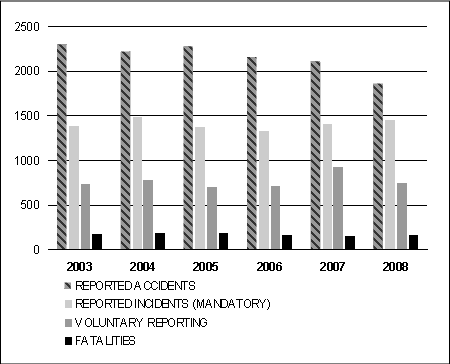 [D]
[D]
Figure 1: Occurrences Reported to the TSB
Investigations Started, in Process, and Completed
In fiscal year 2008-2009, investigations were undertaken for 61 of the occurrences reported to the TSB. In that same period, 88 investigations were completed, compared to 82 in the previous year11. The number of investigations in process decreased to 81 at the end of the fiscal year from 108 at the start. Average time to complete an investigation decreased to 534 days in fiscal year 2008-2009 from 630 days in the previous year.
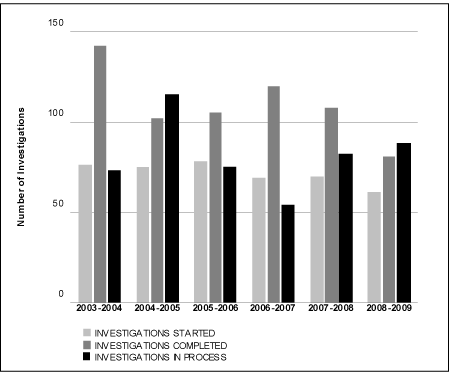 [D]
[D]
Figure 2: Investigations Started, in Process, and Completed
Overall, the TSB has been successful in identifying safety deficiencies and in reducing risks in the transportation system. TSB investigations result in reports identifying safety deficiencies and, where appropriate, contain recommendations to reduce risks. Over this past year, in all cases where the TSB undertook an investigation, safety deficiencies or contributing factors were identified and communicated. These results reflect careful application of the TSB's Occurrence Classification Policy in deciding whether to investigate, and a thorough implementation of the investigation methodology. This systematic approach ensures that TSB investigation resources are invested in areas with the greatest potential safety payoffs.
Safety Communications Issued
In 2008-2009, in addition to investigation reports, the TSB issued a total of 68 safety outputs: 5 recommendations, 31 safety advisories and 32 safety information letters. Safety information is also provided informally to key stakeholders throughout the investigation process, permitting them to take immediate safety actions where appropriate. It is common practice for industry and government to take safety actions during the course of TSB investigations. Such safety actions range widely in scope and importance. Operators will often take immediate remedial action after discussion with TSB investigators. Regulators such as Transport Canada and the Federal Aviation Administration in the United States regularly issue mandatory directives requiring inspections and/or component replacement based on the TSB's preliminary findings. In such situations, rather than issuing recommendations, the TSB can then report on the corrective actions already taken by industry and government agencies.
In accordance with the Canadian Transportation Accident Investigation and Safety Board Act, a federal minister who is notified of a TSB recommendation must, within 90 days, advise the Board in writing of any action taken or proposed to be taken in response, or the reasons for not taking action. The Board considers each response, assessing the extent to which the related safety deficiency was addressed. When a recommendation generates responses from within and outside Canada, the Board's assessment is based primarily on the Canadian response. This year, the TSB continued to publish on its website (http://www.bst-tsb.gc.ca/eng/index.asp) its assessment of industry and government organization responses to its recommendations made after 01 January 2005.
During the period between 01 January 1999 and 31 December 2008, a total of 155 recommendations were assessed by the Board in the fully satisfactory or active (satisfactory intent, satisfactory in part, and unsatisfactory) categories. In addition, 7 recommendations are awaiting Board assessment, bringing the total number to 162.
In the 10-year period from 1999 to 2008, most Board recommendations have resulted in positive change. As shown in Figure 3, for 79% of recommendations (57% fully satisfactory and 22% satisfactory intent), change agents have taken action or plan to take action that will substantially reduce the deficiency noted in the recommendation. For 14% of recommendations (satisfactory in part), change agents have taken or plan to take action that will only partially address the deficiency noted in the recommendation. For 7% of recommendations (unsatisfactory), change agents have neither taken nor plan to take action that will address the deficiency noted in the recommendation.
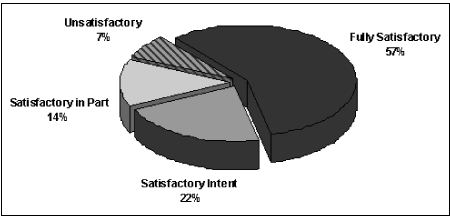 [D]
[D]
Figure 3: Ratings of Assessments of Responses, 1999-2008
Communicating Transportation Safety to Canadians and the Transportation Community
Telling Canadians what we learned during accident investigations is fundamental to advancing transportation safety. The TSB continuously strives to raise awareness of its investigative work, and to issue timely and accurate safety communications to Canadians which explain what happened, why it happened, and what needs to be done to make transportation safer and prevent future accidents.
To this end, the TSB communicates its findings to Canadians through routine updates to the TSB website, the production and dissemination of safety communications and final reports, and through organized media events held across the country.
In 2008-2009, Board Members also pursued a number of key speaking engagements to connect with transportation industry stakeholders and help increase the uptake of TSB recommendations. Of particular note, they marked the 10th anniversary of the crash of Swissair Flight 111 off the shores of Peggy's Cove, Nova Scotia, by speaking at five events in Canada, the United States, the United Kingdom and Russia. These addresses highlighted safety achievements made and outstanding safety deficiencies following our investigation of this tragic accident.
While it is difficult to measure the results of our efforts to increase the reach and stretch the envelope in our communications activities, tangible signs continue to point to a degree of effectiveness of achieving target results. Stakeholders and media use TSB's safety messages in their activities. TSB techniques and methods raise ongoing interest in Canada and around the world.
1.6 Contribution of Priorities to the TSB Strategic Outcome
The following table shows the progress achieved against the management priorities identified in our 2008-2009 Report on Plans and Priorities. We spent $734,925 on our priority projects, whereas our initial forecast was $691,000. This gap is the result of a tight management of our business plans that allowed us to reallocate funds between projects or widen the scope of some of them.
Priorities |
Type |
Status |
Planned Spending ($) |
Actual Spending ($) |
|
|---|---|---|---|---|---|
| Implementation of the recommendations retained from the A-Base Budget Review and its related projects | Previously Committed | Mostly met all expectations. Due to our limited capacity and the need for further analysis in some areas, work was not completed fully. These projects will be fully completed next fiscal year. | 100,000 | 149,562 | |
| Maintaining a knowledgeable and professional workforce | Ongoing | Mostly met all expectations. An integrated human resources plan was developed and implementation has started. Knowledge transfer projects were completed. Significant progress was made on the review and update of employee work descriptions. However, the updating of the Investigators Qualification Program was postponed until next fiscal year and will be undertaken once the new Training and Standards Division is fully operational. | 250,000 | 226,659 | |
| Report Production | Previously Committed | Somewhat met the expectations. Limited progress has been achieved in this area. Renewed efforts will be made in the next fiscal year. | 100,000 | 0 | |
| Continuing the Residual Work in the Area of Information Management | Ongoing | Mostly met all expectations. Residual work remains to be done on the implementation of a comprehensive records management system. | 241,000 | 358,704 | |
| Total | 691,000 | 734,925 | |||
1.7 Expenditure Profile
As shown in the table below, expenditures for 2008-2009 are essentially in line with previous years' expenditures. The only significant increase is in salaries and wages due to the implementation of new collective agreements.
Voted and Statutory Items ($ thousands)
| Vote # or Statutory Item (S) | Wording |
2006-2007 Actual Spending | 2007-2008 Actual Spending | 2008-2009 Main Estimates | 2008-2009 Actual Spending |
|---|---|---|---|---|---|
| Canadian Transportation Accident Investigation and Safety Board | |||||
| 10 | Program Expenditures | 27,473 | 27,104 | 25,589 | 28,251 |
| (S) | Contributions to employee benefit plans | 3,403 | 3,287 | 3,394 | 3,319 |
| (S) | Spending of proceeds from the disposal of surplus Crown Assets | 4 | 39 | 15 | |
| (S) | Expenditures pursuant to paragraph 29.1(1) of the Financial Administration Act | 4 | 10 | 19 | |
| Total | 30,884 | 30,440 | 28,983 | 31,604 |
The following chart shows the TSB spending trend over a three-year period. Reference levels have remained stable over the past three years. However, additional authorities have been provided through Supplementary Estimates and Treasury Board vote transfers. These authorities were essentially intended to cover incremental costs to offset collective bargaining increases and the carry forward of previous years' lapses.
Actual expenditures for 2008-2009 are closely aligned with management's spending plans. Tighter financial management throughout the year has helped ensure a better utilization of resources and to reduce the year-end lapse to approximately $500,000.
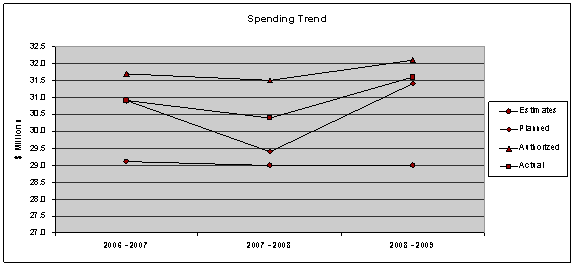 [D]
[D]
Figure 4: Spending Trend

